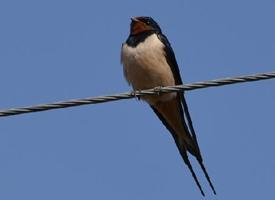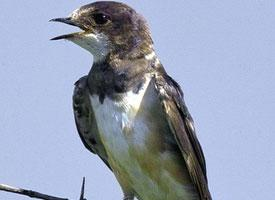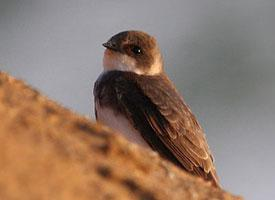
Váhy a míry
| Délka | 19 cm |
|---|---|
| Hmotnost | 20 g |
Popis zvířete
The Barn Swallow (Hirundo rustica) is a small, agile bird known for its distinctive long, forked tail and its graceful, fluid flight. This species, belonging to the family Hirundinidae, is one of the most widespread and easily recognizable swallow species, found across the globe in a variety of habitats. Its presence is often celebrated as a harbinger of spring in many cultures due to its migratory patterns.Physical Description
Adult Barn Swallows typically measure about 17 to 19 cm in length, including their iconic long tail feathers. They have a wingspan of approximately 32 to 34.5 cm, which aids in their agile flying capabilities. The upper parts of their bodies are covered in a glossy blue-black plumage, which contrasts strikingly with their pale underparts. The underparts range from a creamy white to a rich buff, with the throat and forehead often displaying a rufous or chestnut hue. One of the most distinctive features of the Barn Swallow is its deeply forked tail, with the outer tail feathers (streamers) being elongated in mature adults, especially males, which is a trait often associated with attractiveness during mating.
Habitat and Distribution
Originally cave dwellers, Barn Swallows have adapted remarkably well to human habitation, often building their mud nest structures on man-made structures like barns, bridges, and houses, hence their common name. These birds are highly adaptable and can be found in a wide range of habitats, including open country, fields, parks, and near bodies of water, where insects are plentiful.
Barn Swallows are migratory birds, breeding across the northern hemisphere in regions like North America, Europe, Asia, and North Africa, and wintering in the southern hemisphere in South America, southern Africa, and parts of South Asia and Australia. Their migration is a remarkable journey, covering thousands of miles and showcasing their incredible endurance and navigational skills.
Diet
The diet of the Barn Swallow primarily consists of flying insects, including flies, mosquitoes, and beetles, which they catch in mid-air with their open mouths during their acrobatic flights. This diet makes them beneficial to humans by controlling insect populations. Occasionally, they may consume small berries or seeds, but their diet is overwhelmingly insectivorous.
Behavior and Reproduction
Barn Swallows are social birds, often seen flying in groups during migration or when feeding. They communicate with a variety of chirps and calls, which serve purposes ranging from signaling danger to strengthening social bonds within the flock.
During the breeding season, Barn Swallows are monogamous and exhibit remarkable nest fidelity, often returning to the same nesting sites year after year. The female lays 3 to 7 eggs, which are incubated for about two weeks before hatching. Both parents share responsibilities for feeding the chicks and defending the nest. The young swallows fledge approximately 18 to 23 days after hatching but may continue to be fed by their parents for some time.
Conservation Status
The Barn Swallow is currently listed as Least Concern by the International Union for Conservation of Nature (IUCN), reflecting its wide distribution and large global population. However, like many bird species, it faces threats from habitat destruction, pesticide use, and climate change, which could impact its numbers and distribution in the future. Conservation efforts focused on preserving natural habitats and promoting environmentally friendly farming practices are vital to ensuring the continued survival of this iconic species.
In summary, the Barn Swallow is a remarkable bird, admired for its beauty, agility, and beneficial role in insect control. Its widespread presence across many parts of the world has made it a subject of fascination and endearment in various cultures, symbolizing the changing of seasons and the interconnectedness of our global ecosystem.
Mapa výskytu

Podobná zvířata
Nové fotografie zvířat
Top 10 zvířat
- Chinese water dragon (Physignathus cocincinus)
- Galápagos tortoise (Geochelone nigra complex)
- Dolphin gull (Leucophaeus scoresbii)
- Japanese macaque (Macaca fuscata)
- Colombian red howler (Alouatta seniculus)
- Sea urchins (Echinoidea)
- Diana monkey (Cercopithecus diana)
- Moustached guenon (Cercopithecus cephus)
- Common house mosquito (Culex pipiens)
- Colossal squid (Mesonychoteuthis hamiltoni)


